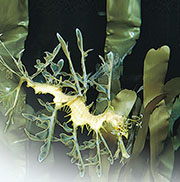Animal:Leafy seadragon, master of disguise
【明報專訊】The leafy seadragon ( 葉海龍 ) is probably one of the most awesome-looking marine animals. You won't be able to tell that it's an animal— it looks like floating seaweed! And it certainly doesn't look like a fish, which it actually is.
Of course the leafy seadragon is not wearing this disguise for fun. It is a matter of staying alive in nature, keeping safe from predators and feeding on unsuspecting prey.
All these leaves
LET'S take a closer look at a leafy seadragon. The ''leaves'' are actually leaf-shaped appendages, or green-coloured attachments that serve to disguise. They are olive in colour and resemble floating seaweed to the extent that they can change colour and sway with water currents, helping the leafy seadragon to blend in perfectly with its surroundings.
Its head is small, and its snout is like a long, thin pipe. It has a long tail, which is about half its body length of 35cm. The dorsal and pectoral fins (背鰭及胸鰭) are small and fine, and there are no caudal and pelvic fins (尾鰭及腹鰭). Ill-equipped in terms of fins, the leafy seadragon is a poor swimmer and relies on its leafy camouflage to avoid predators. For defensive purposes, it has long, sharp spines growing out from each of its bony plates.
Papa gives birth
MALE leafy seadragons are responsible for childbearing, and they even have a spongy brood patch under their tails to carry their babies! As the eggs are transferred from the female to the male, they are fertilised by the male and then incubated for about four to six weeks. Baby seadragons are born with full features, like miniature versions of the adults, except that their leafy appendages have not been formed yet. They are fully independent after birth and need no parental care. On the first two days, they stay in shallow waters and live off the egg capsule that is still attached to their body. Soon their snouts are more fully grown and they are ready to go hunting!
Leafy seadragons are found in the temperate waters off south and east Australia, among seaweed beds, seagrass meadows, rocky reefs and sandy patches close to the reefs. They feed on plankton(浮游生物), baby fish and small shrimps. In their brilliant seaweed disguise, they approach their prey quietly and then suck it up whole using their snout.
Since leafy seadragons are coastal dwellers, their natural habitats are much at risk from pollution and destruction by human activities. They are prone to being caught as incidental bycatch in fisheries. What ideas do you have to provide a healthier environment for these animals?
Text and photos:Ocean Park Hong Kong
[Smarties' Power English 第311期]





